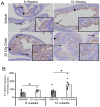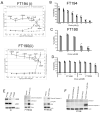Vitamin D Significantly Inhibits Carcinogenesis in the Mogp-TAg Mouse Model of Fallopian Tube Ovarian Cancer
- PMID: 39408285
- PMCID: PMC11478811
- DOI: 10.3390/nu16193318
Vitamin D Significantly Inhibits Carcinogenesis in the Mogp-TAg Mouse Model of Fallopian Tube Ovarian Cancer
Abstract
Epidemiological and observational studies suggest that vitamin D has potential for the chemoprevention of ovarian cancer. The anticancer effect of vitamin D in the fallopian tube epithelium (FTE), which is now thought to harbor the precursor cells for high grade ovarian cancer, is not known. The purpose of this study was to investigate whether vitamin D can inhibit carcinogenesis in the mogp-TAg fallopian tube (FT) ovarian cancer mouse model and examine underlying mechanisms. To test this hypothesis, 3 groups of 40 5-week-old female mogp-TAg mice were divided equally into two cohorts of 20 mice, treated with either vehicle (vitamin D solvent) or the active 1,25(OH)2D3 analogue EB1089, delivered via mini-pump or IP injection or cholecalciferol delivered in the feed. The FTs were characterized histologically and pathologically after 3 and 7 weeks of treatment. The effect of vitamin D on cultured human FTE cells was also examined. After 3 weeks, vitamin D, delivered as either cholecalciferol or EB1089 significantly inhibited FT carcinogenesis. After 7 weeks, cholecalciferol significantly reduced p53 signatures, serous tubal epithelial carcinoma, FT cancer, and plasma CA125 while increasing apoptosis in the FTE. EB1089 had no significant effect on FT carcinogenesis at 7 weeks. Cholecalciferol significantly reduced proliferation and increased apoptosis in vitro in p53-altered FTE cells. In conclusion, vitamin D inhibited FT carcinogenesis by clearing cells with p53 alterations. These data suggest that vitamin D has merit for the chemoprevention of fallopian tube/ovarian cancer. The optimal chemopreventive effect may be dependent on the route of vitamin D administration.
Keywords: carcinogenesis; chemoprevention; cholecalciferol; fallopian tube epithelium; mogp-TAg; vitamin D.
Conflict of interest statement
The authors declare no potential conflicts of interest, with the exception of Rodriguez, who has patents on the use of vitamin D for ovarian cancer prevention, but none have commercial value.
Figures






References
-
- American Cancer Society . Cancer Facts & Figures 2024. American Cancer Society; Atlanta, GA, USA: 2024.
-
- Folkins A.K., Jarboe E.A., Saleemuddin A., Lee Y., Callahan M.J., Drapkin R., Garber J.E., Muto M.G., Tworoger S., Crum C.P. A candidate precursor to pelvic serous cancer (p53 signature) and its prevalence in ovaries and fallopian tubes from women with BRCA mutations. Gynecol. Oncol. 2008;109:168–173. doi: 10.1016/j.ygyno.2008.01.012. - DOI - PMC - PubMed
MeSH terms
Substances
Grants and funding
LinkOut - more resources
Full Text Sources
Medical
Research Materials
Miscellaneous

